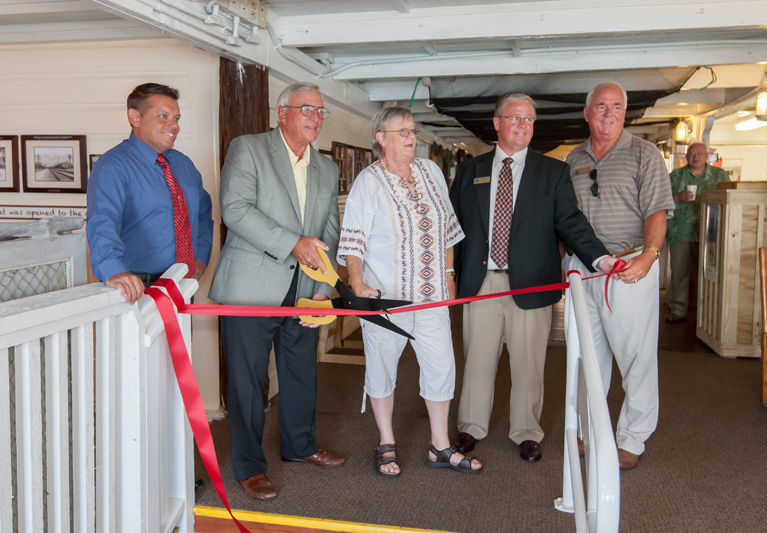
SEBASTIAN — “We truly are living up to our name as a small fishing village.” Sebastian City Councilwoman Andrea Coy has come to Fisherman’s Landing/Crab- E-Bill’s with 30-plus other government officials, dignitaries and friends, gathered on the morning of May 13 to celebrate the completion of the historic display which wonderfully tells the story of the city’s fishing heritage, and is a key component of the Working Waterfront project.
The display consists of numerous photographs, illustrated information panels and standalone exhibits throughout the building.
The back porch and deck offer unimpeded views of the Indian River Lagoon and the docks that will soon, as in generations past, house a working fish house, to which local fishermen will bring their daily catch for processing.
Visitors will be able to watch from observation areas along the docks or on real-time monitors inside the building.
Museum professional and Sebastian resident Wilma Bertling and County Historian Ruth Stanbridge are the dynamic duo who labored for months, putting together the unique exhibit.
Prior to the official ribbon cutting, Sebastian Mayor Richard Gillmor presented proclamations to Stanbridge and Bertling.
City Manager Joe Griffin welcomed guests, and recognized several who have worked diligently on the project, including City Director of Operations Jerry Converse and his assistant Billy Wilson, who did much of the construction; and Growth Management Director Rebecca Grohall, who wrote the grant application and project management plan.
Gillmor acknowledged former state representative and Sebastian resident Charlie Sembler as the original driving force behind the project. Sembler, an artist and visionary, represents the fourth generation of a pioneer fishing family.
It was Sembler who worked with the late state representative Stan Mayfield to create the Stan Mayfield Working Waterfront Grant program, to help communities such as Sebastian return their dying fishing industries to life, and Sembler who first urged the City Council to seek the grant.
“Although Charlie cannot be here today,” said Gillmor, “his fingerprints are all over this.”
Sembler has created and refurbished numerous pieces on the property, including wooden benches; an authentic flat-bed ”fish cart” on rails; large metal fish sculptures in and along the lagoon; a stone and shell fountain; and a stunning driftwood gate at the entrance to the docks where the working fish house will soon be operating.
Gillmor also credited the late Richard Stringer, former City Attorney, with helping move the project forward.
Other attendees included several City department heads and staff members; County Commission Chairman Wesley Davis and County Commissioner Peter O’Bryan, Sebastian Councilmember Jim Hill; representatives from Florida Inland Navigation District and St. John’s River Water Management District; Sebastian Chamber of Commerce head Beth Mitchell, Sebastian businessman and original project committee member John Conway; and Anjani Cirillo, president of the Sebastian Clambake Foundation, which donated to the project.
Mitchell, who served on the original Working Waterfront committee, observed, “It is not easy putting together a public/private partnership. Though there were several bumps in the road, it has all come together exactly as envisioned. Preserving a piece of history is always important and this is a way to show our visitors that the real Florida does not stop at the beach.”
Derek Busby, a director of the Indian River Lagoon National Estuary Program said, “I had the good fortune of previewing the project, and I’m impressed with how it offers the history of Sebastian all in one place and how well it ties the community to the resource.”
Jerry Sansom, Florida Inland Navigation District Vice-Chair for Brevard County, said the Working Waterfront Grant program is “an extremely good program, and Sebastian has done an excellent job in following through on what the WWF Grant was meant to do.”



